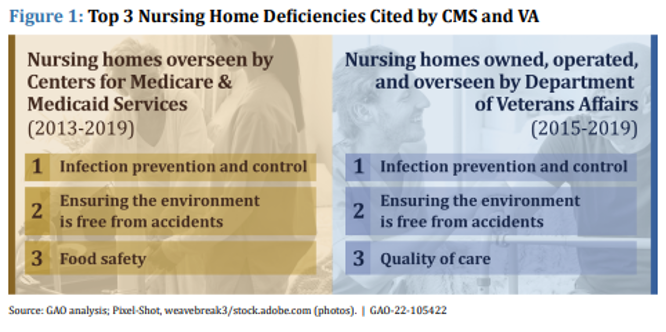Mary Madison, RN, RAC-CT, CDP
Clinical Consultant – Briggs Healthcare
The Government Accountability Office has posted this January 2022 Health Care Capsule to “summarize past GAO reports on concerns about nursing home quality of care, consumer information, and COVID-19. It also describes relevant GAO recommendations and agency efforts to address them and identifies relevant policy questions.”
This Health Care Capsule summarizes our extensive work on nursing homes, including our assessments of the quality of care, COVID-19 response, consumer information concerns, and more. The pandemic brought into sharper focus problems with nursing home quality that we have long highlighted, such as persistent infection control challenges.
We have recommended, among other things, that the government provide consumers with more information on care quality—such as more data on nurse staffing and COVID-19 vaccination rates. We also recommended ways to make it easier for consumers to compare the quality of care in nursing homes across the nation.
The COVID-19 pandemic has brought into sharper focus problems with nursing home quality that GAO has reported on—and made recommendations to address—for many years, and some of these recommendations have yet to be implemented. Specifically, GAO has identified gaps in CMS’s oversight that made it harder to protect nursing home residents from abuse and concerns about VA’s oversight of the nursing home inspection process it uses to ensure quality of care. In addition, in the years prior to the pandemic, infection prevention and control deficiencies, such as failure to use proper hand hygiene, were the most common type of deficiency cited by surveyors in nursing homes. (See fig. 1) Many of the same nursing homes were repeatedly cited for these infection prevention and control deficiencies year after year, indicating persistent quality of care problems.
Nursing homes have experienced a disproportionately high number of COVID-19 deaths when compared to the general U.S. population. Efforts to reduce the spread of COVID-19 in nursing homes led to changes in infection prevention and control practices, including restricting loved ones and friends from visiting during critical points in the pandemic to prevent transmission. The resulting isolation raised concerns about unintended harm to residents, since isolation can increase loneliness, anxiety, and depression. Additionally, resident advocates, such as ombudsmen, were restricted from entering, limiting oversight of facilities during the pandemic. Nursing home visitation was allowed again for all residents beginning in November 2021, and public health officials emphasize the need for nursing homes to remain vigilant in maintaining proper infection prevention and control practices while balancing the psychosocial health needs of residents.
This 2-page GAO report is well worth the read. Please review and share it with your team and colleagues.


